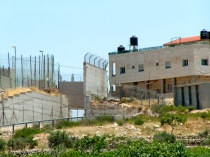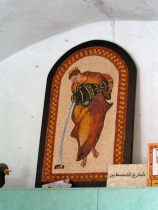You are welcome
We spent most of yesterday in the West Bank, visiting supplier groups of Sunbula, the fairtrade shop which was founded by Carol Morton, the wife of the late Colin Morton, one of St Andrews Church’s previous ministers. There is still a Sunbula shop in the guest house, and a larger one in the city. We were a group of five, and as we left the city, we could already see a hill above the village we were to visit first. Ordinarily, it would take about 15 mins to drive there from Jerusalem, if it were not for the Barrier. We had to pass the Qualandiya checkpoint, and so entered the West Bank. While we were not even stopped, it was quite shocking to see quite how young the soldiers at the checkpoints are – little more than teenagers, if that, with their big machine guns. Ramallah is a beautiful town as well, and is considered the economic, social and political centre of the West Bank. I was fascinated by some of the contrasts – like having a Government building on one side of the road, and a big herd of shaggy goats on the other. However, I found the traffic less fascinating – as in Jerusalem, everyone seems to drive just like they want, without much consideration for anyone else.
 Driving through the West Bank, of course we saw the Barrier Wall, the ‘Security Fence’. Of course, from Israeli perspective, thinking back to the bombings in the Second Intifada, this appears to be sensible. However, if the wall is there the ensure the security of the Israelis, often of those in the settlements within the West Bank, which have been recognised as illegal by the international community, I do wonder why the wall goes incredibly close by Palestinian houses, while making big circles around the settlements, leaving lots of space in which plenty more houses can go up, while at the same time cutting into Palestinian land, disregarding much of the ‘Green Line’ agreed on.
Driving through the West Bank, of course we saw the Barrier Wall, the ‘Security Fence’. Of course, from Israeli perspective, thinking back to the bombings in the Second Intifada, this appears to be sensible. However, if the wall is there the ensure the security of the Israelis, often of those in the settlements within the West Bank, which have been recognised as illegal by the international community, I do wonder why the wall goes incredibly close by Palestinian houses, while making big circles around the settlements, leaving lots of space in which plenty more houses can go up, while at the same time cutting into Palestinian land, disregarding much of the ‘Green Line’ agreed on.
 We first went into the village of Beit Doqu, where we visited a community project, the Beit Doqu Development Society. The Barrier has brought huge implications for the people living in the West Bank. Although technically the village is very close to Jerusalem, those working in the city have to take the long detour through the West Bank and the checkpoints (to work in Jerusalem, the men also must be older than 40 and have a clean record). This journey, which took us less than an hour, takes much longer for them, through the waiting times at the checkpoints, so that most of them leave the village by 2am to get to work for 8am. The Barrier of course also reduces the amount of the agricultural land of the villages, and cuts some farmland off from the villages. In order to reach these farms – if accessible at all; some farmland now can simply not be cultivated anymore – the villagers must wait for Israeli soldiers to unlock gates – sometimes waiting from the early morning, only to be met at 10 or 11am, and again, sometimes not being let out in the evenings until very late. The society however is able to still do some agricultural work, employing local people to help with it, and with the subsequent processing of the produce like the bottling of the olive oil. Sunbula has been able to secure some grants, and with these resources started to train more people in crafts. In this village, some of the women now make beautiful jewellery, which is sold in the fairtrade shops.
We first went into the village of Beit Doqu, where we visited a community project, the Beit Doqu Development Society. The Barrier has brought huge implications for the people living in the West Bank. Although technically the village is very close to Jerusalem, those working in the city have to take the long detour through the West Bank and the checkpoints (to work in Jerusalem, the men also must be older than 40 and have a clean record). This journey, which took us less than an hour, takes much longer for them, through the waiting times at the checkpoints, so that most of them leave the village by 2am to get to work for 8am. The Barrier of course also reduces the amount of the agricultural land of the villages, and cuts some farmland off from the villages. In order to reach these farms – if accessible at all; some farmland now can simply not be cultivated anymore – the villagers must wait for Israeli soldiers to unlock gates – sometimes waiting from the early morning, only to be met at 10 or 11am, and again, sometimes not being let out in the evenings until very late. The society however is able to still do some agricultural work, employing local people to help with it, and with the subsequent processing of the produce like the bottling of the olive oil. Sunbula has been able to secure some grants, and with these resources started to train more people in crafts. In this village, some of the women now make beautiful jewellery, which is sold in the fairtrade shops.  From the profits of the community project, achieved mostly through international collaboration, the centre was able to establish both a computer suite and a library for the village, stocking many of the books necessary for the studies of the village’s university students. However, what touched me most was the incredible hospitality and generosity of the people. They really don’t have very much, starting with the basics we take for granted like water – the water supply in the West Bank mostly is granted on one day per fortnight, and most of the houses keep big water storage tanks on their roofs. Nevertheless, we were greeted with glasses of juice, then offered the traditional Arabic coffee, and eventually fresh figs, just harvested. They might not have much, but they make the most of it – for themselves, their visitors and their communities.
From the profits of the community project, achieved mostly through international collaboration, the centre was able to establish both a computer suite and a library for the village, stocking many of the books necessary for the studies of the village’s university students. However, what touched me most was the incredible hospitality and generosity of the people. They really don’t have very much, starting with the basics we take for granted like water – the water supply in the West Bank mostly is granted on one day per fortnight, and most of the houses keep big water storage tanks on their roofs. Nevertheless, we were greeted with glasses of juice, then offered the traditional Arabic coffee, and eventually fresh figs, just harvested. They might not have much, but they make the most of it – for themselves, their visitors and their communities.
 We also visited to embroidery workshops, each employing local women to embroider and saw bags, rugs, wall hangings, purses, ….. This way, the traditional Palestinian patterns and colours are kept alive, and the women are able to add an income where often there is none. One of these workshops is situated in Amari, a refugee camp in Ramallah, an area which we most likely would have described as slum. And yet again, the work done there offers perspectives, and certainly displays lots of joy and pride in the craft.
We also visited to embroidery workshops, each employing local women to embroider and saw bags, rugs, wall hangings, purses, ….. This way, the traditional Palestinian patterns and colours are kept alive, and the women are able to add an income where often there is none. One of these workshops is situated in Amari, a refugee camp in Ramallah, an area which we most likely would have described as slum. And yet again, the work done there offers perspectives, and certainly displays lots of joy and pride in the craft.
The last project we visited was a cultural one in Birzeit. This beautiful village appears quite empty. Nevertheless, looking behind the first impression, much is going on. For some years now, a ‘Birzeit Heritage Week’ takes place annually, taking pride in showing the local culture. The Al-Rozana Mosaic Workshop has opened, pursuing the traditional art of mosaic. A photo gallery is being planned. So much creativity and energy are shown there! Many houses have been built up (from the traditional style used until about 60 years ago, of one upstairs room, which the whole family would share, with a ground floor part in which the animals were kept), with the help of international founding. In all these places, international support and investment has been apparent, and it seemingly has been applied in great ways. Again, the hospitality was amazing: while we were being shown through the village, one of the villagers, on passing his house, invited us in, and offered us coffee, while telling us a bit about his family.
The life in the villages is not easy. While previously, any produce could have been sold in a number of markets, now Ramallah is the only one accessible. This of course means that there are too many goods for the customers, and that prices fall. Access to workplaces like Jerusalem, or to beautiful sides – we could see the Mediterranean from the car – is hugely restricted. Many families have left the country, others are divided: the husband of one of the women who welcomed us works in the US, sending back money to support his family.
And yet, in all the places we went, we were greeted with a warm ‘you’re welcome!’ – in the villages as well as in the workshops, by the partners expecting us as well as by passing villagers. Our own ‘shokran – thank you’ – felt quite inadequate as a response.
Of course, this is a biased, one-sided view, perhaps even confirming the views I brought here with me. Perhaps I will start understanding the reasoning for what is happening here as well at some point, but for now I can only describe what I experienced.